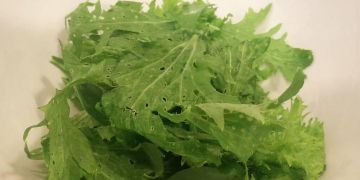Cultivation
As its first alternate name implies, the wasabi is grown in Japan in natural environments alongside open bodies of water. It can reach heights of 30 centimeters, and its leaves, which are dark green and shaped like a kidney, can grow to 15 centimeters long by 15 centimeters wide. Seeds grow on the Wasabi plant in small, white flowers that attach themselves to the stem. This is referred to as it rhizome.
Because the wasabi needs an ideal and naturally occurring environment in which to grow, it is a rare plant which thrives only in certain areas of Japan. The demand for natural wasabi is very high, and this has caused the Japanese to create environments where it can be artificially cultivated and also to rely on imports from China. Genuine wasabi is rarely found in the United States or Canada. Thus far only the state of North Carolina and the province of British Columbia has been able to recreate the ideal growing environment for wasabi.
Ingredients
Allyl isothiocyanate is the ingredient in wasabi that is responsible for its strong odor. Wasabi's unique taste comes from other isothiocyanate compounds which are created by reactions between cells of the rhizome, which for wasabi are on the plant's long stem. When the cells are burst, such as due to eating or crushing, a reaction occurs between different components within different cells in the stem. These components are normally kept separate by the cell walls, so the taste isothiocyanate compounds are not present within the plant unless damage occurs to the stem to burst the cells and allow the chemicals to mix and therefore react. The reaction to produce the isothiocyanates is between rhizome thioglycosides (which are compounds containing glucose sugar and sulfur, also known as thiol) and water. This hydrolysis reaction is catalyzed by the enzyme myrosinase and only occurs when the enzyme is released as cells burst. The production of these isothiocyanates is therefore a defence mechanism by the plant to discourage animals from eating it. We humans are a strange species as we actually seek out these pungent tastes!
Lots of plants have a similar defence mechanism of pungent tastes produced when cells are damaged, and many of these chemicals have health benefits to humans as they are designed to react with the creatures eating them, namely other mammals.
Medical Uses and Health Benefits
Antioxidant properties
Every part of the wasabi plant is used to promote health and well-being. Its leaves and stems are ground into antibacterial medicines, which aid in the treatment of respiratory problems like a cough, cold or sinus pressure. The wasabi can also be used to treat diarrhea, stimulate the appetite and remove toxins from the body. Wasabi is well-known for its strong antioxidant and digestive stimulant properties and can be used to promote overall wellness and not just the treatment of illnesses and disease symptoms.
Clears sinuses
The most well-known use of wasabi for medical purposes is to clear clogged sinuses. Since the odor of the wasabi is so powerful, it takes only a few seconds of inhaling the scent for the nasal passages to clear and allow the person the ability to breathe normally again. However, if too much wasabi is inhaled, it can cause burning and pain on the inside of the nasal cavity.
Current research
Scientists continue to study the health benefits made possible by the ingredients found in wasabi, although not all uses have been approved for use with the general public yet. It has recently been discovered that certain plants materials in the wasabi can be given to patients to prevent the formation of blood clots. Even more promising, it is thought that some of the substances within the plant can prevent the growth of human cancer cells found in the lining of the stomach.
Condiments Containing Wasabi
Wasabi is known for its strong taste and hotness when used as a condiment to accompany favorite food dishes. It can be found most frequently in horseradish, mustard and chili peppers. The Japanese frequently flavor their sushi and sashimi by sprinkling it with wasabi. It is also used as a flavor enhancer with noodles, soup, rice, fish and meats that have been barbecued. Since its spicy taste and temperature are quite intense, it is not recommended to use more than a dash of it on food, especially if someone is tasting wasabi for the first time.
Only a few restaurant owners in the United States have been able to obtain naturally grown wasabi. Since it is very costly for them to purchase, the price must be passed down to the customer. People in North America who love the taste of wasabi usually have to settle for a less-expensive alternative which is created by mixing horseradish and mustard for flavor and green food coloring for the visual appeal.
Other Uses
In addition to adding flavor to food and being used as ingredients in medicine, the wasabi plant can be ground and added to toothpaste. Since it loses flavor and potency quickly, it is usually sold in smaller, travel sized tubes of toothpaste.





